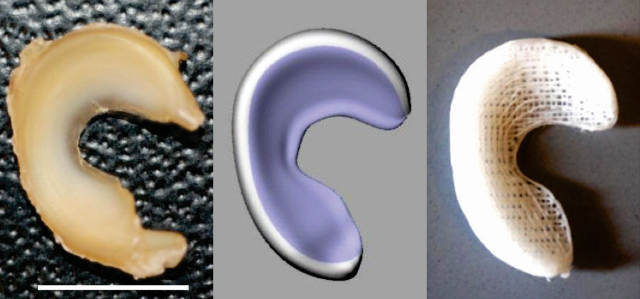A 3D-printed scaffold infused with growth factors has been shown to help regenerate knee joint linings in sheep.
Damage to this lining, called the meniscus, can lead to debilitating arthritis. Although implants were studied in sheep, the structure of the knee joint is very similar to that of humans.
 Left to right: Sheep meniscus; 3D model of meniscus obtained from laser scanning; 3D-printed anatomically correct meniscus scaffold. (Credit: Lab of Dr. Jeremy Mao)
Left to right: Sheep meniscus; 3D model of meniscus obtained from laser scanning; 3D-printed anatomically correct meniscus scaffold. (Credit: Lab of Dr. Jeremy Mao)
The study was lead by Jeremy Mao, DDS, PhD, the Edwin S. Robinson Professor of Dentistry (in Orthopedic Surgery) at Columbia University Medical Center. He commented:
"At present, there’s little that orthopedists can do to regenerate a torn knee meniscus. Some small tears can be sewn back in place, but larger tears have to be surgically removed. While removal helps reduce pain and swelling, it leaves the knee without the natural shock absorber between the femur and tibia, which greatly increases the risk of arthritis.”
Sometimes, damaged menisci can be replace by a meniscal transplant, using tissue from cadavers or from other parts in the body. In the United States, around one million meniscus surgeries are done every year - however, the procedure is risky, and success rates are low.
The method developed by Dr. Mao involves taking MRI scans of the meniscus in its intact form in the undamaged knee. A 3D image is derived from these MRI scans. This data is then used with a 3D printer to produce a scaffold with a 10μm resolution. The scaffold is printed using polycaprolactone material that is used for producing surgical sutures. A scaffold matching the shape of the meniscus can be printed in about 30 minutes.
Dr. Mao’s team infused the scaffold with transforming growth factor β3 (TGFβ3) and connective growth factor (CTGF), recombinant human proteins. They discovered that when these two recombinant human proteins were delivered sequentially, they attracted stem cells in the body and induces them to create new meniscal tissue.
These proteins have to be released in a particular order and in specific areas so that the meniscus forms properly. In order to achieve this, these proteins need to be encapsulated in two different types of polymeric microspheres that dissolve slowly. CTGF is released first in order to stimulate outer meniscus production. This is followed by TGFβ3 which induces the production of the inner meniscus. The scaffold infused with proteins is then inserted into the knee. The meniscus took about 4-6 weeks to regenerate in sheep. Later on, the scaffold dissolves and is safely removed by the body.
Dr. Mao said:
“This is a departure from classic tissue engineering, in which stems cells are harvested from the body, manipulated in the laboratory, and then returned to the patient—an approach that has met with limited success. In contrast, we’re jumpstarting the process within the body, using factors that promote endogenous stem cells for tissue regeneration.
Scott Rodeo, MD, sports medicine orthopedic surgeon and researcher at Hospital for Special Surgery in New York City, who co-authored the paper, added:
“This research, although preliminary, demonstrates the potential for an innovative approach to meniscus regeneration. This would potentially be applicable to the many patients who undergo meniscus removal each year.”
The researchers tested this therapy in 11 sheep. The sheep were randomized into two groups- a treatment group and a non-treatment group. The treatment group received a protein-infused 3D scaffold as replacement for their knee meniscus, while the non-treatment group received a 3D scaffold without protein. The sheep that received treatment began walking normally after three months.
The researchers also performed postmortem analysis, where they observed that the regenerated meniscus of sheep in the treatment group demonstrated mechanical and structural properties that were close to that of natural menisci. Further studies are being conducted to find out if the regenerated tissue would be long-lasting.
The researchers are seeking funding to commence clinical trials of the treatment.
Dr Mao predicts that in clinical use, personalized scaffolds for meniscus regeneration could be produced within a few days. These would then be sent to hospitals, within a week of the initial MRI scan.
Lisa Ann Fortier, DVM, professor of large animal surgery at Cornell University College of Veterinary Medicine in Ithaca, N.Y., comments:
“These studies provide clinically valuable information on the use of meniscal regeneration in the knees of patients with torn or degenerate menisci. As a veterinary orthopedic surgeon-scientist on this multi-disciplinary team, I foresee the added bonus of having new techniques for treating veterinary patients with torn knee meniscus.”
The National Institutes of Health, the American Orthopaedic Society for Sports Medicine, the Arthroscopy Association of North America, and the Harry M. Zweig Foundation have provided funds for this study.
Knee Meniscus Regenerated with 3D-Printed Implant
Sources and further reading
“Protein-Releasing Polymeric Scaffolds Induce Fibrochondrocytic Differentiation of Endogenous Cells for Knee Meniscus Regeneration in Sheep” - J. J. Mao et al, Sci Transl Med 2014